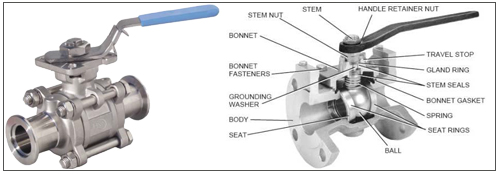Ball Valve

A Ball valve is a quarter-turn rotational motion valve that uses a ball-shaped disk to stop or start flow. If the valve is opened, the ball rotates to a point where the hole through the ball is in line with the valve body inlet and outlet. If the valve is closed, the ball is rotated so that the hole is perpendicular to the flow openings of the valve body and the flow is stopped.We are an ISO 9001:2008,ISO 9001-2008, ISO 14001-2004, OHSAS 18001-2007, NSIC-CRISIL, EEPC, and QA-UKAS (ISO 9001-2008), SSI Certified company that follows total Quality Management System. and have been recognized as one of the world’s leading stockists and manufacturer of quality metals for over two decades and are committed to quick responses, unsurpassed quality, competitive pricing, reliable deliveries and an exhaustive inventory.
Ball valve Specification
| Type | Ball valve |
| Standred | DIN 3352 F5 |
| Material | Industrial-grade steel, carbon steel, stainless steel, alloy steel and special steel, A105, A182, F304, F316 |
| Size | DN025 to DN300 |
| Diameter | 1/2 "to 56" |
| Order | Accept custom order |
Construction of a Ball valve
Ball valves are quarter-turn, straight-through valves that have a round closure element with matching rounded seats that permit uniform sealing stress. The valve gets its name from the ball that rotates to open and close the valve. Ball valves are used in situations where tight shut-off is required. They are wide duty valves, able to transfer gases, liquids and liquids with suspended solids (slurries).
Advantages and disadvantages of Ball valve:
Advantages:
• Superior ease of operation• Maintains and regulates high volume,high pressure, and high temp flow
• Rugged construction and long service life
• Low purchase and maintenance cost
• Able to function without side loads
• Permits inspection and repair of seats and seals without removing the valves' body from the line
• Does not require lubrication
Disadvantages:
• Poor throttling characteristics• Difficult to clean, leads to contamination
Types of Ball Valve:
Ball valve have a very distinct globe shape. The disk, valve stem, and the hand wheel are the moving parts in the valve body. The body is available in three different designs depending on the application as well as three different types of disks.

Ball valves are basically available in three versions: full port, venturi port and reduced port. The full-port valve has an internal diameter equal to the inner diameter of the pipe. Venturi and reduced-port versions generally are one pipe size smaller than the line size.Ball valves are manufactured in different body configurations and the most common are:
• Top entry Ball valves allow access to valve internals for maintenance by removal of the valve Bonnet-cover. It is not required to be removed valve from the pipe system.
• Split body Ball valves consists of a two parts, where one part is smaller as the other. The ball is inserted in the larger body part,and the smaller body part is assembled by a bolted connection.The valve ends are available as butt welding, socket welding, flanged, threaded and others.
Packaging Of Ball valve
1.Hessian / PVC Cloth Bundles with PVC Box Strap or Hexagonal Bundles2.Wooden Crate
3.Wooden Box made of treated wood or Plywood sheet
4.Bundles (hexagonal)
5.Crates (steel/wooden)
6.Special Crates
Application Of Ball valve
1.Food Industries2.Water Industries
3.Oil & Gas Industries
4.Automotive Industries
5.Ship Building Industries
6.Petro-Chemical Industries
7.Engineering Cement Industries
8.Transport Industries-Rail and Road
9.Chemical & Pharmaceutical Industries
10.Construction Industries / Building Systems
